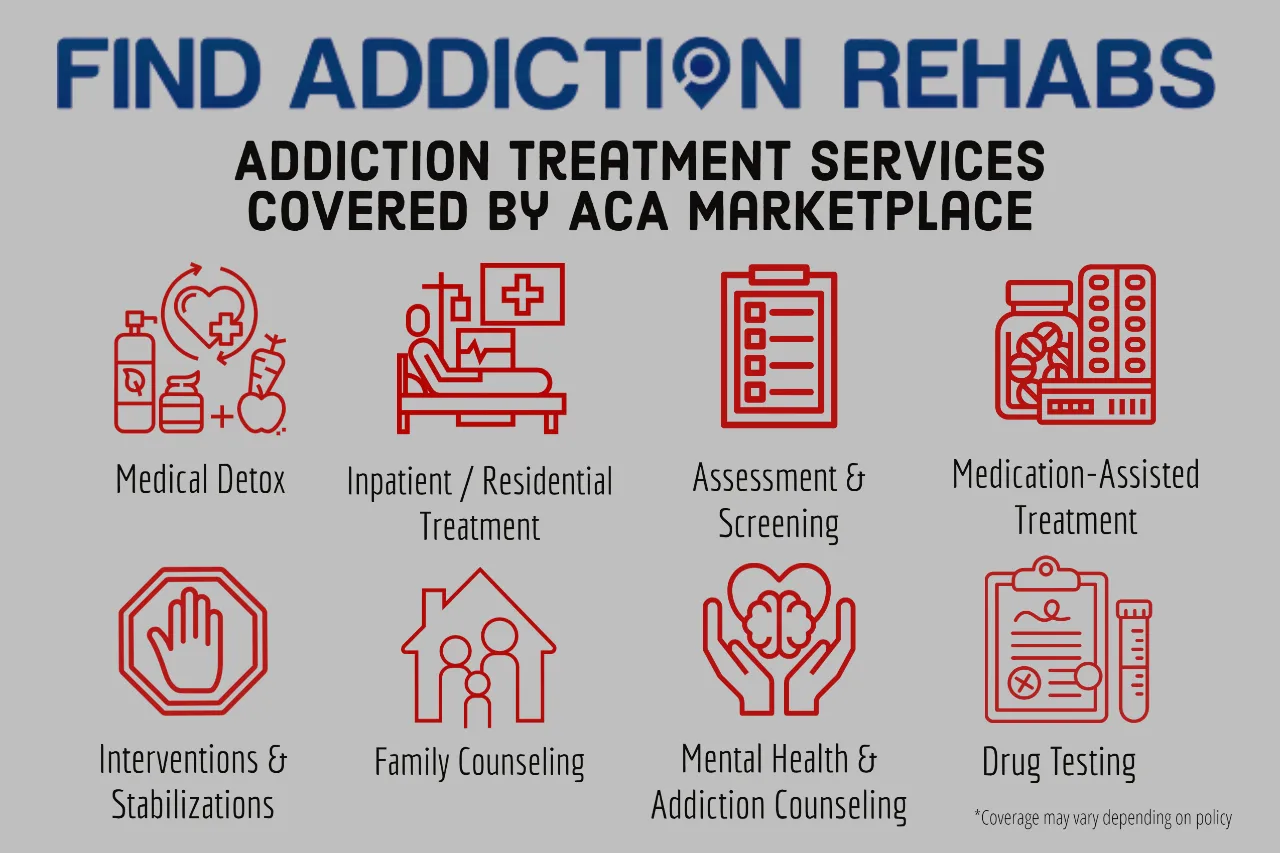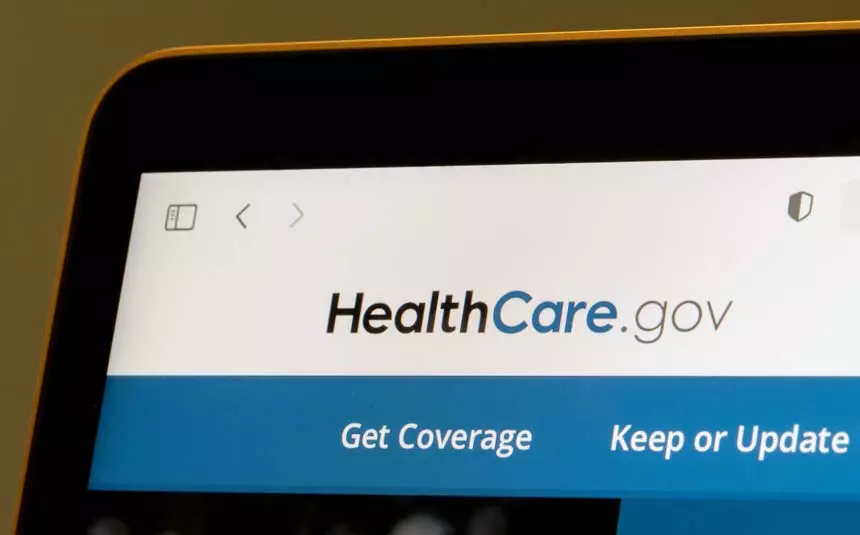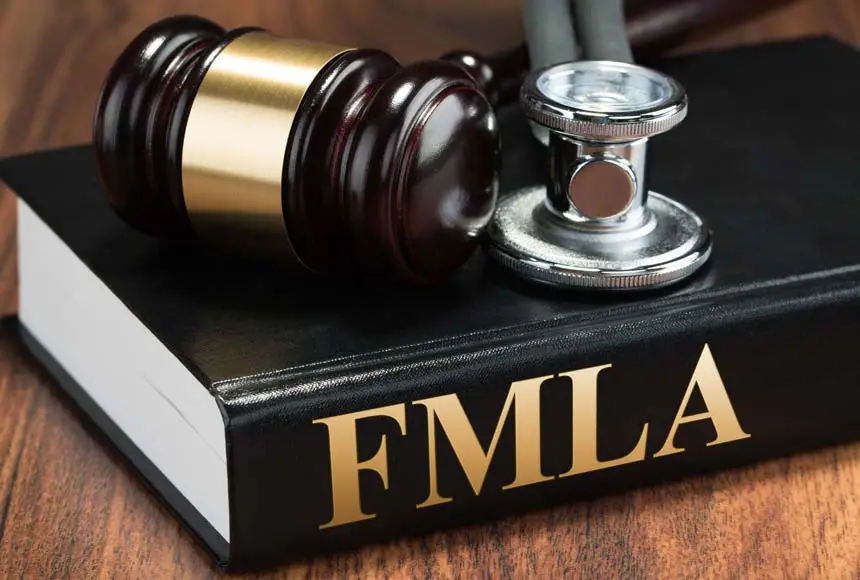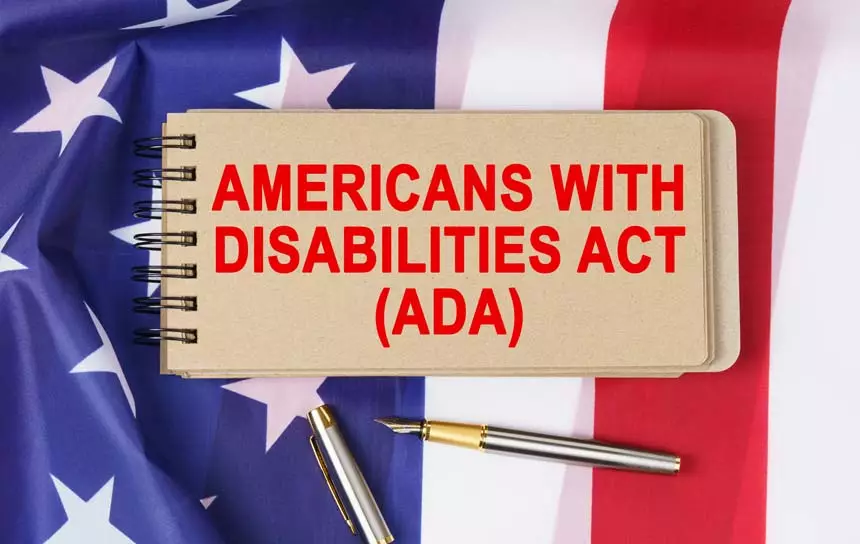Finding Addiction Treatment through the ACA Marketplace
Table of Contents
- Finding Addiction Treatment through the ACA Marketplace
- What Does the ACA Cover?
- How Does The ACA Treat Addictions and Pre-Existing Conditions?
- Who is Eligible for ACA Coverage?
- Income-Based Assistance – How Does It Work?
- Different Levels of ACA Coverage
- How to Choose the Best Plan for Substance Abuse Coverage?
- Out-of-Network Providers and the ACA
- Job Safety During Your Treatment Stay
- Conclusion – The Cost of Rehab vs. Cost of Addiction
One of the United States’ biggest public health crises revolves around the issue of substance use disorder (or SUD). The numbers paint a grim picture: over the last 15 years, opioid-related overdose deaths have increased more than 200%, and continue to affect the lives of millions. For this reason, we’ve written our guide to help you choose a plan for addiction treatment using the Marketplace (through the Affordable Care Act).
Clearly, there’s a need for insurers to carry out a thorough treatment plan for addiction patients – from outpatient services to detoxification, psychotherapy, and medication. There’s a lot of work that goes into helping an addict recover – help that wasn’t readily available to thousands of Americans pre-2010.
Passed in 2010 as part of the Health Care and Education Reconciliation Act, the ACA or Affordable Care Act has greatly expanded the scope of treatment through insurance coverage expansions, insurance reforms that include SUD treatments, and more.
Are you or a loved one currently suffering from a SUD? If so, read on to learn more about the benefits ACA coverage provides, along with terms, substance abuse plans, and even how the ACA helps with job safety during treatment.
What Does the ACA Cover?

The ACA sponsors insurance plans on an online platform called the Health Insurance Marketplace (or just the Marketplace). Here, you can apply for coverage on addiction treatment, amongst many other options.
In general, however, the ACA aims to improve health insurance coverage across the United States. It categorizes its services and items as ‘essential health benefits’ or EHBs, across 10 different categories:
- Ambulatory patient services
- Emergency services
- Hospitalization
- Maternity and newborn care
- Mental health and substance use disorder services, including behavioral health treatment
- Prescription drugs
- Rehabilitative and habilitative services and devices
- Laboratory services
- Preventive and wellness services and chronic disease management
- Pediatric services, including oral and vision care
Clearly, the program is fairly exhaustive and has experienced great progress with respect to the state of medical coverage across the United States.
How Does The ACA Treat Addictions and Pre-Existing Conditions?
Many private insurers do not cover pre-existing medical conditions – substance abuse being a common example. The ACA, on the other hand, dismisses addiction as a pre-existing condition – allowing addiction treatment to become vastly more accessible.
ACA also takes the condition very seriously – available insurance plans through the Marketplace can include:
- Addiction evaluation
- Brief intervention
- Addiction treatment medication
- Clinic visits
- Alcohol and drug testing
- Home health visits
- Family counseling
- Anti-craving medication
The ACA and insurance coverage gained through the Marketplace also helps with inpatient services such as a detox program, where you would have the ability to remain at a medical facility for the course of your treatment.
Who is Eligible for ACA Coverage?

Health coverage eligibility for ACA is straightforward in its conditions. To enroll, you must:
- Live in the United States
- Be a U.S. citizen or national, or be lawfully present
- Not be incarcerated
Keep in mind that if you have Medicare coverage, you’re not eligible for ACA coverage simultaneously – more on that here.
Income-Based Assistance – How Does It Work?
One of the first steps to filling out an ACA application to begin looking for coverage on the Marketplace is estimating your approximate household income for the year.
This figure is used to calculate exactly how much financial assistance you stand to gain through the act, and is subject to a fair number of terms.
2021 includes a major change to the way income-based subsidies work. In previous years, households earning between 100-400% of the federal poverty level were eligible for subsidies – obtaining percentage discounts for the number of people in the household compared against income levels.
As part of 2021’s American Rescue Plan, the rules have changed, at least till the end of 2022. In an attempt to help facilitate households beyond the previous 400% threshold, ACA now ensures that these households will not have to pay over 8.5% of their income for a benchmark plan – the second-lowest expensive silver plan.
This continues all the way down to the highest possible subsidy level, as follows:
- 400% of poverty line or higher = 8.5%
- 300% to 400% of poverty line = 6% to 8.5%
- 250% to 300% of poverty line = 4% to 6%
- 200% to 250% of poverty line = 2% to 4%
- 150% to 200% of poverty line = 0% to 2%
- Income up to 150% of poverty = 0% (Subsidies cover 100% of the benchmark plan)
After processing, you can pick a lower-cost plan by paying a smaller premium amount or pay extra for a higher-level plan.
Different Levels of ACA Coverage
Most insurance plans, from those provided by Aetna, to those from UnitedHealthcare, associated with ACA will fit into one of the four following categories – each of which offers a range of payment splits depending on your medical needs, you will see each type as you browse the Marketplace options:
| Plan Category | The insurance company pays | You pay |
| Bronze | 60% | 40% |
| Silver | 70% | 30% |
| Gold | 80% | 20% |
| Platinum | 90% | 10% |
The distinction between each plan is clear – they offer different premiums and out-of-pocket costs across their term length. Let’s understand this a bit better with a couple of examples.
Example 1:
In the first scenario, let’s consider a young woman in her twenties – let’s call her Jaina.
Jaina works a standard 9-5 and keeps herself in great shape. She’s got no major risks for diabetes or any hereditary disorders – and she’s aiming to save up money to launch her own business sometime in the future.
Jaina’s life circumstances, age, and general health point her in the direction of Bronze and Silver plans. It’s clear that she would choose low monthly premiums and higher out-of-pocket costs, but why?
In a nutshell, it’s because Jaina does not need routine intensive medical care and he doesn’t expect to deal with regular costs regarding medication, hospitalization, and more.
Furthermore, she is not responsible for any other household members, and could benefit by putting the dollars she’s saved on cheaper monthly premiums towards her business.
Example 2:
In the second scenario, let’s take the example of Jeff. After a long battle with alcoholism, Jeff’s family has convinced him to apply for ACA insurance programs.
While Jaina was in good health, Jeff is a lot older. In his 50s, his health has caught up with him – resulting in various issues that need routine management, medication, and checkups.
In Jeff’s case, he is likely to benefit from choosing a Gold or Platinum plan.
This is because not only will he regularly have to file insurance claims for his existing medical costs – the new help he seeks to get for his addiction, along with his responsibility for other household members, results in more overall savings if he chooses a plan with higher monthly premiums and lower out-of-pocket costs.
To make things clear, your choice of ACA plan category depends on the following questions:
- How often do you visit the doctor or hospital?
- Do you need regular care multiple times a year?
- How many prescriptions do you need to take?
- Are there trusted specialists or preferred institutions in your specific insurance plan?
- Do you qualify for cost-saving reductions?
Take a long look at your household priorities and health history before making a decision. Here’s a helpful general video from the Healthcare.gov website itself, with more details on choosing a plan for Substance Abuse Coverage through the Marketplace coming up next.
How to Choose the Best Plan for Substance Abuse Coverage?
Fortunately, the Marketplace as provided through the ACA takes mental health and substance abuse services quite seriously, classifying them as essential health benefits.
While there are several variables that go into choosing a substance abuse-focused health plan, the following points are key cornerstones that you should look out for:
- Inpatient Treatment: Access to treatment centers and halfway houses.
- Counseling: Professional treatment in cognitive behavioral therapy, contingency management, motivational enhancement therapy, group counseling, and more.
- Medication: Detoxification, anti-withdrawal, relapse prevention medication, etc.
A good plan will also get you help in the form of peer support communities or even fellowships such as Alcoholics Anonymous.
This means that you should be able to visit and get treated at a rehabilitation center without needing to pay out-of-pocket, or at least through a considerable subsidy. Keep in mind though, that the actual benefits depend on your specific health plan and the state that you live in.
The Marketplace (through the ACA) also ensures a few protections regarding your right to mental and behavioral health. For starters, ACA-approved insurance plans cover pre-existing conditions and do not enforce spending limits.
This means that you will not be charged extra for a plan if you already suffer from a substance use disorder. The day you start your coverage, you are entitled to benefits regarding any pre-existing issues.
How Does Maintenance Medication Fit Into the ACA?

One of the most polarizing aspects of substance abuse healthcare is that of maintenance medication.
In the case of severe addiction, sometimes, patients are too dependent on their substance of choice to go ‘cold turkey’ right away – to prevent the onset of debilitating withdrawal, many centers prefer to administer alternative drugs that can assist with recovery long-term.
The issue is that these medications are only covered if deemed ‘essential’ – possibly depriving recovering addicts of much-needed help.
While the Marketplace currently has manifested a general push towards more open and addict-friendly insurance policies, it’s well worth checking beforehand to ensure that you receive the level of treatment that’s best for your health.
Out-of-Network Providers and the ACA
While all medical facilities in association with your insurance plan network should work out fine, what if you have to seek aid at an out-of-network provider?
In the case of health emergencies where the nearest available emergency room is out-of-network, your insurance is legally obliged to cover the treatment as if it were administered in-network.
There is a catch, however. As the out-of-network emergency room does not have a contract with your insurer, they aren’t necessarily obligated to render the insurance amount as ‘paid in full’. As a result, you could receive a ‘balance bill’ for the remaining amount, which can come as a nasty shock. Depending on your provider (such as Blue Cross Blue Shield) you can ask about compliance with the insurer itself, as well as check with the facility where you are seeking treatment (or the reps at Find Addiction Rehabs) to discover the exact costs of your entire treatment.
Fortunately, the government has noticed this flaw in the Marketplace coverage and has implemented new federal rules to counter it, effective 2022. Under the ‘No Surprises Act’, patients can avail of in-network rates across a much wider range of scenarios – preventing unfair billings in the wake of emergency treatments and other events, such as:
- Natural disasters
- Provider status changing midway through a complex treatment
- No in-network providers available at your location
Job Safety During Your Treatment Stay
If you require inpatient care to manage your disorder, you may be concerned about the status of your job – several recovering addicts face a tough choice between paying bills and getting the help they need.
Fortunately, you have legal protections on your side. These can help you take the time you need to recover and heal, without sacrificing your career in the process:
Family Medical Leave of Absence Act (FMLA)

Incorporated in 1993, the FMLA provides certain employees with up to 12 weeks of unpaid, job-protected leave per year, while maintaining their group health benefits. Your employer is also obligated to keep the same pay, benefits, and other terms and conditions of employment once you return from rehabilitation – although you are required to inform them beforehand through a physician’s note.
A few points to keep in mind regarding FMLA:
- To qualify, you must work for a public or private employer for at least 12 months
- Your 12 unpaid weeks of leave must fit into a 12-month period
- The FMLA ensures that your employer continues to provide health insurance coverage during your absence
Americans with Disabilities Act (ADA)
According to the ADA, people suffering from substance abuse disorder should receive certain anti-discriminatory protections when reintegrating into society – especially through employment.
ADA essentially protects job security for rehab patients as well as successfully recovered patients – for employers with 15 or more people on the payroll.
Remember that ADA is unlikely to help, however, if you are currently abusing drugs and alcohol – especially if used at the workplace or if impeding your work performance.
Remember – when it comes to disclosing and opening a dialogue regarding rehab treatment with an employer, it is always best to be proactive and bring up the issue yourself – along with a medical letter.
This way, you maintain a degree of transparency and professionalism with your employer, while ensuring that you remain well within the protection of the ADA and FMLA.
Conclusion – The Cost of Rehab vs. Cost of Addiction
Hopefully, we’ve provided a useful primer that can get you closer to the treatment you or a loved one needs. For more detailed information on specific types of coverage and general advice on plans and providers, please visit our ‘Obamacare for Addiction Treatment,’ article that goes a bit further into these areas.
Let’s take a moment, however, to address the common point between substance abuse and health insurance – the cost faced by an addict, and the society that surrounds them.
For starters, rehab can be tremendously expensive – and with a less-than-stellar reputation in the media and only a few big-name rehabs, some people can find themselves questioning their choices once signing up for rehabilitation, through the Marketplace or otherwise.
If we take a moment to objectively look at the cost of rehab, it primarily factors in:
- The range of services you need
- The intensity of your rehab program
- Treatment location
- Specific client needs (you may be pregnant, have chronic health issues, or need specific mental health treatment)
- Length of rehab program
- Labor and resources
While the ACA helps greatly with making this burden less heavy, there’s no real federal benefit scheme to help you through a commitment to stick to drug use.
The costs here are much more abstract, painful, and irreversible:
- Difficulty retaining employment
- Conflict with interpersonal relationships
- Physical dependence and withdrawal symptoms
- Risky behaviors and possible incarceration
- Mental and physical health issues
We could go on and on – perhaps one way to illustrate the scope of this crisis is how much it costs the United States itself. Studies claim that substance abuse costs the country a staggering $600 billion a year – making it a truly debilitating crisis not just on the level of an individual, but society too.
Don’t let money keep you away from living a life of health and recovery – with the ACA, affordable, effective rehab programs are just a step away. If you have further questions, please reach out to our hotline staff at Find Addiction Rehabs now, don’t delay the decision to get healthy!
* Disclaimer: Find Addiction Rehabs is not affiliated with or endorsed by the Marketplace. Details about Marketplace coverage are intended for informational purposes only. The specific details of your plan may vary and the specific treatment services you require may or may not be covered. Please call our representatives today for more definitive details on your plan and options.
References
- Abraham, A. J., Andrews, C. M., Grogan, C. M., D’Aunno, T., Humphreys, K. N., Pollack, H. A., & Friedmann, P. D. (2017, January). The affordable care act transformation of substance use disorder treatment. American Journal of Public Health. Retrieved October 14, 2021, from.
- Barry, C. L., Huskamp, H. A., & Goldman, H. H. (2010, September). A political history of federal mental health and Addiction Insurance Parity. The Milbank Quarterly. Retrieved October 14, 2021, from.
- Department of Health and Human Services. (n.d.). Get 2021 health coverage. Health Insurance Marketplace®. HealthCare.gov. Retrieved October 14, 2021, from.
- The United States Government. (2021, October 8). American Rescue Plan. The White House. Retrieved October 14, 2021, from.
- What is a benchmark plan? healthinsurance.org. (2021, August 20). Retrieved October 14, 2021, from
- Barry, C. L., Goldman, H. H., & Huskamp, H. A. (2010). A political history of federal mental health and Addiction Insurance Parity. The Milbank Quarterly. Retrieved October 14, 2021, from.
- House – Energy and Commerce; Education and Labor. (2019, September 7). H.R.3630 – No Surprises Act. Retrieved October 14, 2021, from.
- United States Code. (n.d.). Americans with Disabilities Act of 1990, As Amended. Retrieved October 14, 2021, from.
- United States Department of Labor. (n.d.). Family and medical leave (FMLA). Family and Medical Leave (FMLA). Retrieved October 14, 2021, from.
- National Institute on Drug Abuse. (2020, June 3). Is drug addiction treatment worth its cost? National Institute on Drug Abuse. Retrieved October 14, 2021, from
Eric R. does extensive work in the field of behavioral health as both a professional writer and passionate advocate for those suffering. From his own personal encounters with mental illness, he speaks to those seeking healthy relief from depression and anxiety and embraces wellness both personally and professionally. After losing friends and family to the darkness of suicide, Eric aims to educate and inform about the nature of treatment and render it accessible for all those seeking a way out of darkness and despair.


